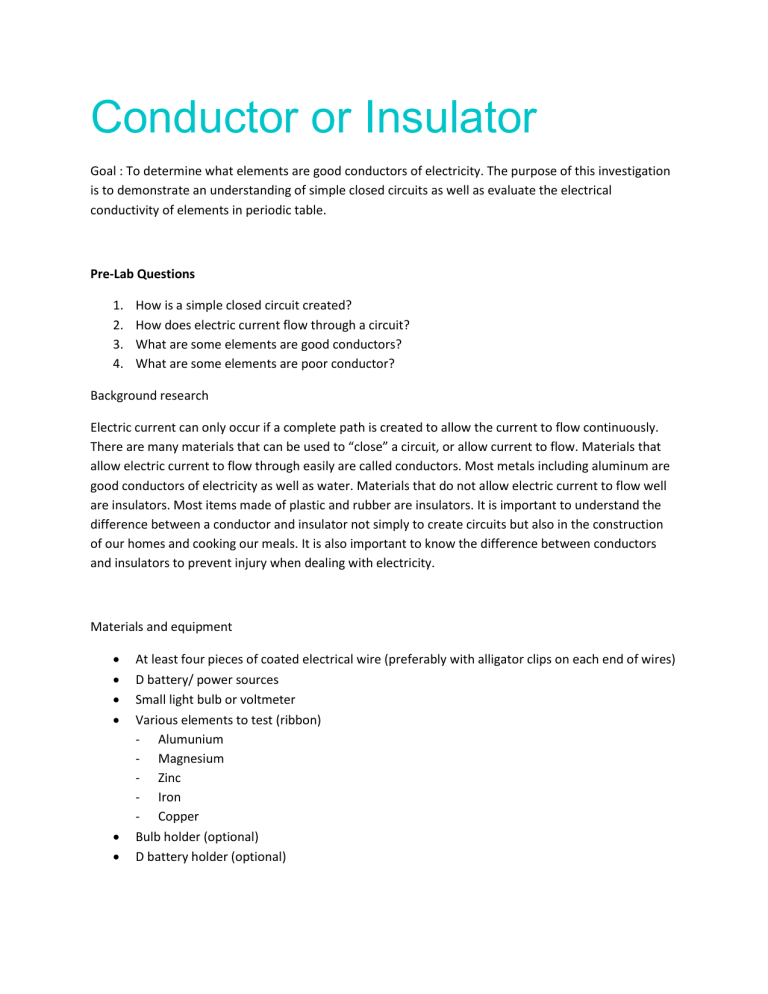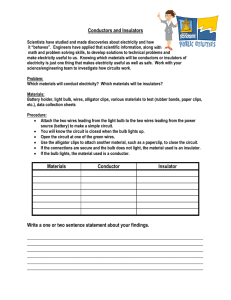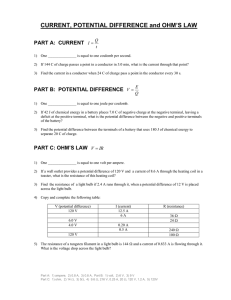
Conductor or Insulator Goal : To determine what elements are good conductors of electricity. The purpose of this investigation is to demonstrate an understanding of simple closed circuits as well as evaluate the electrical conductivity of elements in periodic table. Pre-Lab Questions 1. 2. 3. 4. How is a simple closed circuit created? How does electric current flow through a circuit? What are some elements are good conductors? What are some elements are poor conductor? Background research Electric current can only occur if a complete path is created to allow the current to flow continuously. There are many materials that can be used to “close” a circuit, or allow current to flow. Materials that allow electric current to flow through easily are called conductors. Most metals including aluminum are good conductors of electricity as well as water. Materials that do not allow electric current to flow well are insulators. Most items made of plastic and rubber are insulators. It is important to understand the difference between a conductor and insulator not simply to create circuits but also in the construction of our homes and cooking our meals. It is also important to know the difference between conductors and insulators to prevent injury when dealing with electricity. Materials and equipment At least four pieces of coated electrical wire (preferably with alligator clips on each end of wires) D battery/ power sources Small light bulb or voltmeter Various elements to test (ribbon) - Alumunium - Magnesium - Zinc - Iron - Copper Bulb holder (optional) D battery holder (optional) Instructions ` Create a simple closed circuit by connecting two wires to the battery and light bulb. See diagram for example. If not using a bulb holder or battery holder, you can connect the wires by clipping the alligator clip of one wire to the positive post of the battery and the other end to the metal contact (bottom tip) of the bulb. Attach the alligator clip of a second wire to the bottom or negative side of the battery by using masking tape or simply holding the clip in place.(USE CAUTION if holding clip.Heat can be generated.)Attach the other end of the wire to the metal threaded cap of the bulb.If your circuit is correctly closed and a complete path is created, the bulb will light. Next you will test your items to see if they are conductors or insulators. elements to test. Include items made of different materials such as metal, and metalloid. Incorporate one item at a time into your circuit to test if it is a conductor or insulator. Start by disconnecting one alligator clip from the bulb and attaching the clip to the test item. Connect another wire to the test item and then back to the bulb. If the bulb lights, the test item is a conductor. If the bulb does not light, the test item is an insulator. The following chart is an example of a chart that could be used to record your observations and data. Elements Good conductor (voltage) Poor conductor (voltage) References: Science Turns Minds On. (1995) New York: McGraw-Hill http://indianamichiganpower-in.apogee.net/kids/?ver=kkblue&utilid=indianamichiganpowerin&id=16185 Author: Angela Pike





